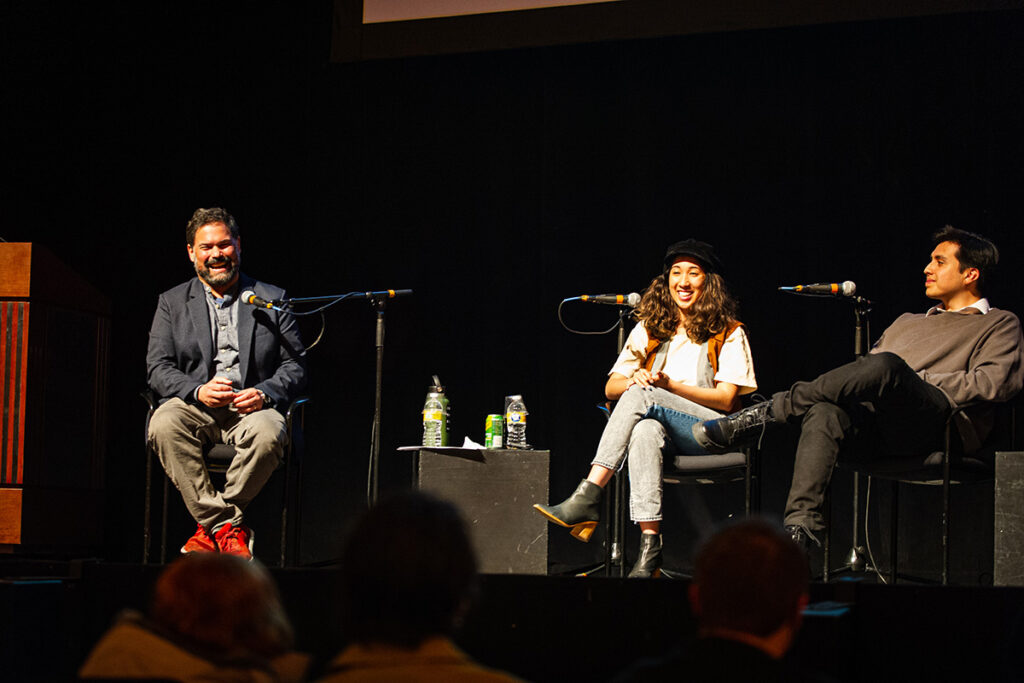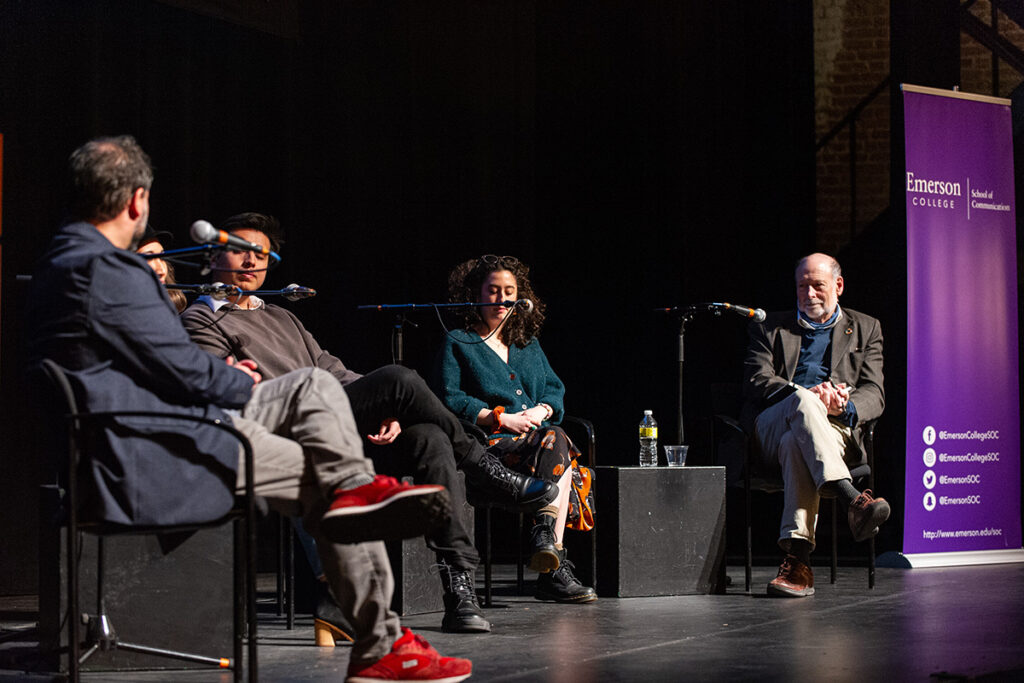SOC Students Learn to Change the World, One TikTok at a Time

Between and among all the “kids dancing” on TikTok are the content creators trying to harness the platform for good.
On March 23 and 24, the School of Communication brought two of those people to Emerson to demonstrate how to create compelling content on TikTok that educates, motivates, entertains, and inspires, all in the name of repairing the planet.
Kristy Drutman (@browngirlgreen) and Isaias Hernandez (@queerbrownvegan) are members of EcoTok, a collective of environmental activists founded in 2020 who use TikTok to educate and promote sustainability, conservation, and social and environmental justice.
On Wednesday, March 23, Drutman and Hernandez took the stage of the Emerson Cutler Majestic Theatre to talk about their work and where they’ve found success in spreading the word about climate change and sustainability. Joining them for the conversation were Marketing Communication Associate Professor Nejem Raheem, an environmental economist; Jack Spengler, Akira Yamaguchi Professor of Environmental Health and Human Habitation at Harvard’s T.H. Chan School of Public Health; and Emilia Cardona ’22, a Journalism major and Environmental Studies minor at Emerson.
The following afternoon, the EcoTokers led a workshop on creating effective issue-focused social media posts with Emerson students.
Here are some of Drutman’s and Hernandez’s insights:

Encourage curiosity:
Isaias Hernandez: I think it’s so much easier for younger generations, especially Gen Z, to be able to ask what you would call, not even dumb questions – they don’t exist – but curiosity. They’re able to start to have these conversations, because I think at times, at educational institutions, we can feel ashamed or embarrassed by our peers who might not ever think to ask this question.
Keep it concise and accessible:
Kristy Drutman: All the time, we have to think about what are the key points? What are the key arguments? What is the key evidence? Do you think it’s A) going to compel an audience; B) going to do well in research? Is it putting in facts? You need them. C) How are you actually going to be able to make that plan and have people maintain focus on what your main argument is?
Everything is about making content digestible. Something that’s really important to us is to think about the accessibility around our content. So we think about closed captioning, we think about visuals, like colors. We think about what are we putting in the background? Something you’re pulling from an article? Making sure that maybe we’ll zero in on a specific statement. Just points like that won’t have people so overwhelmed about, ‘You have to go read this whole thing now.’
Motivate, don’t terrify:
Kristy Drutman: A big part of [the International Panel on Climate Change (IPCC) report] is that there’s a lot of doom and gloom around what is possible when it comes to the climate crisis. But at the same time, the scientists and policy makers all agree that there’s still a window of hope.
When it comes to thinking about the window of hope, we have to maximize our resources and our communication channels to be able to tap into that, right? Ultimately, that is why creating content that feels purposeful, that gives people pathways to act, gives them resources that they can share with other people. Because what we find at EcoTok, it’s a really big issue that a lot of people care about these issues, they just don’t know where to start, they don’t know what resources to access because a lot of this has been either shrouded in agony or even locked up in nonprofits.
Inform and connect:
Isaias Hernandez: An important note to address here is [that] local journalism has been declining over the last few decades, and that is very scary… So what does that mean for someone that’s 18, 19, or in college? They’re going, ‘I just want to find out what’s happening in my community.’ So we try our best to find local issues and local problems that are happening in our areas so younger people in those areas can get involved.
Whether that’s getting involved or connected to a local organization, or whether that’s just signing up for a workshop that’s hosted by institutions or NGOs, we really want to emphasize the fact that no one should ever feel alone in this fight, [in] the climate crisis, specifically. We provide just so [many] resources, not just on mental health wellbeing, but the physical resources, like [people] who you may want to get connected to: scientists, organizations, individuals.
Authenticity is key:
Kristy Drutman: We shouldn’t have to have X, Y, and Z degrees to be allowed to be in this conversation. We can’t afford that anymore. The climate fight can’t be just that, and it can’t be all about the media anymore. … I think social media and the work we do, that accessibility is really a pathway towards that. It’s the beginning of a culture shift that could happen.
That’s where we think you all can come in to the conversation… Users want something authentic. They don’t want just this polished pedestal that is just activists they look up to. Sure, maybe they want that, but they also want to see a person in everyday life. They want to see the struggle, they want to see the difficulties. That’s what we do in this work.
Categories